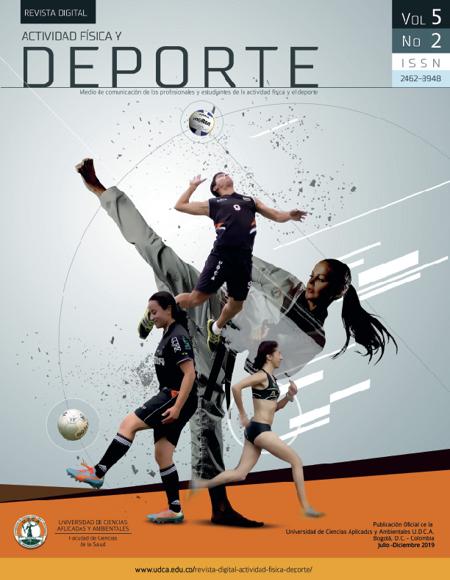INFLUENCIA DE LA SUPERSTICIÓN EN EL RENDIMIENTO DEPORTIVO DE UN EQUIPO PROFESIONAL DE FÚTBOL DE COLOMBIA: UN ESTUDIO DE CASO
INFLUENCE OF THE SUPERSTITION IN THE PERFORMANCE OF A PROFESSIONAL FOOTBALL TEAM OF COLOMBIA: STUDY OF CASE
Contenido principal del artículo
Resumen
Este trabajo investigativo-estudio de caso, tiene como propósito comprender la influencia que tiene la superstición y los rituales religiosos, instaurados por una líder espiritual, sobre el rendimiento deportivo de un equipo profesional de fútbol. Para llevar a cabo el desarrollo de este artículo se realizó una investigación de tipo cualitativa y se diseñó un análisis de las narrativas y conductas, de los principales jugadores del equipo deportivo y de la líder espiritual, por medio de entrevistas radiales y un documental, que se transcribieron para poder analizar aquellas palabras más usadas en cada discurso por medio de un generador de nubes; luego se correlacionaban, estas palabras, con la ficha de aceptación o rechazo de la superstición de De Miguel et al., (2012).
Se encontró que las conductas supersticiosas generan un aumento de la confianza, producto de la relación causal que hacen los deportistas entre los rituales realizados y las victorias conseguidas inmediatamente después. Se identificó, además, que al considerar real esta situación, se implementa una sensación de control sobre las circunstancias, lo que produce un aumento de la motivación al momento de competir.
Palabras clave:
Descargas
Detalles del artículo
Referencias (VER)
Abbot, K. y Sherratt, T. (2011). The evolution of superstition through optimal use of incomplete information. Animal Behaviour, 82, 85-92.
Bandura, A. (1977). Self-efficacy: Toward a unified theory of behavioral change. Psychological Review, 84, 191-215.
Beck, J., y Forstmeier, W. (2007). Superstition and belief as inevitable by-products of an adaptive learning strategy. Human Nature, 18(1), 35-46.
Berger, P. y Luckman, T. (1968). La construcción de la realidad. Buenos Aires: Amorrortu
Buceta, J. (1995). Intervención Psicológica en deportes de equipo. Revista de Psicología General y Aplicada, 48(1), 95-110.
Damisch, L., Stoberock, B., y Mussweiler, T. (2010). Keep your fingers crossed! How superstition improves performance. Psychological Science, 21(7), 1014-1020.
De Miguel, J; Martín, N. y Márquez, M. (2012). Relaciones entre el deseo de control y la superstición. Estudios de Psicología, 33, 219-230.
Dudley, R. (1999). The effect of superstitious belief on performance following an unsolvable problem. Personality and Individual Differences, 26(6), 1057-1064.
Feltz, D. (1988). Self-confidence and sports performance. Exercise and Sports Science Reviews, 16, 423-457.
Hoffman, S. (2010). Prayer out of bounds. Good Game: Christianity and the Culture of Sports (pp. 239-262). Waco, TX: Baylor University Press.
Jahoda, G. (1969). The psychology of superstition. Oxford, England: Penguin Books, Oxford.
Keinan, G. (1994). Effect of stress and tolerance of ambiguity on magical thinking. Journal of Personality and Social Psychology 67 (1), 48.55.
Keinan, G. (2002). The effects of stress and desire for control on superstitious behavior. Personality and Social Psychology Bulletin, 28(1), 102-108.
Langer, E. (1975). The illusion of control. Journal of Personality and Social Psychology, 32, 311-328.
Langer, E. (1977). The psychology of chance. Journal for the Theory of Social Behaviour, 7, 185-207.
Lindeman, N., y Aarnio, K. (2006). Paranormal Beliefs: Their Dimensionality and Correlates. European Journal of Personality, 20, 585-602.
Lobmeyer, D. y Wasserman, E. (1986). Preliminaries to free shooting superstitious behavior? Journal of Sports Behavior, 9, 70-78
Malinowski, B. (1954). Magic, science and religion, and other essays. Garden City, NY: Doubleday.
Maranise, A. (2013). Superstition & religious ritual: An Examination of their Effect and Utilization in Sport. The Sport Psychologist, 27, 83-91.
Morse, W. y Skinner, B. (1957). A second type of superstition in the pigeon. American Journal of Psychology, 70, 308-311
Neil, G. (1980). The place of superstition in sport: The self-fulfilling prophecy. Coaching Review, 3, 40-42.
Nideffer, R. (1976). Test of attentional and interpersonal style. Journal of Personality and Social Psychology, 34, 394-404.
Pena, D. (2004). Scripture and sport psychology. (pp. 9-126). New York, NY: iUniverse, Inc.
Peterson, C. (1978). Locus of control and belief in self-oriented superstitions. The Journal of Social Psychology, 105(2), 305-306.
Robinson, S. (2007). Spirituality: a working definition. In J. Parry, S. Robinson, N. Watson, & M. Nesti (Eds.), Sport and Spirituality: An Introduction (pp. 22-37). London: Routledge.
Rosenthal, R. y Jacobson, L. (1968). Pygmalion in the classroom: teacher expectation and pupils’ intellectual development. New York: Holt, Rinehart and Winston.
Rosenthal, R. y Babad, E. (1985). Pygmalion in the Gymnasium. Educational Leadership, 43(1), 36-39.
Salah, A. (2006). Christian presence in sporting institutions. In S. Rylko (Ed.), The world of sport today: a field of Christian mission (pp. 127-130). Rome: Libreria Editrice Vaticana.
Schippers, M. y Van Lange, P. (2006). The psychological benefits of superstitious rituals in top sport: A study among top sportspersons. Journal of Applied Social Psychology, 36(10), 2532-2553.
Skinner, B. (1948). Superstition in the pigeon. Journal of Experimental Psychology, 38, 168-172.
Thomas, W. y Thomas, D. (1928). The Child in America: Behavior problems and programs. Kopf.
Tinoco, J., González, M. & Arciga, S. (2009). Factores de la religiosidad y preferencia política en estudiantes universitarios. Enseñanza de Investigación en Psicología, 14(2), 275-293.
Tobacyk, J. y Milford, G. (1983). Belief paranormal phenomena: Assesment Intrument develpment and implications for personality functioning. Journal of Personality and Social Psyhology, 44, 1029-1037.
Tobacyk, J. (2004). A revised paranormal belief scale. The international Journal of Transpersonal Studies, 23.
Vyse, S. (1997). Believing in Magic. New York, NY: Oxford University Press.
Watson, N. y Czech, D. (2005). The use of prayer in sport: Implications for sport psychology consulting. Athletic Insight: The Online. Journal of Sport Psychology, 7(4), 26-31.
Womack, M. (1992). Green cars, black cats, lady Luck. Dans S. J. Hoffman (Ed.), Sports and Religion (pp. 203-212). UK: Human Kinetics Publishers.
Whitson, J. y Galinsky, A. (2008). Lacking control increases illusory pattern perception. Science, 322(5898), 115-117.
Zebb, B. y Moore, M. (2003). Superstitiousness and perceived anxiety control as predictors of psychological distress. Journal of Anxiety Disorders, 17(2), 115-130.
Zivanovic, N., Randelovic, N. & Savic, Z. (2012). Superstitions and rituals in modern sport. Activities in Physical Education and Sport, 2(2), 220-224.
WEBGRAFÍA
Steiner, B. (1944/1999). How to define superstition? En J. Adler y R. Fardon (eds.), Taboo, Truth and Religion, Oxford, Berghahn Books, (pp. 223-229). Disponible en español en http://sisbib.unmsm.edu.pe/BibVirtual/libros/Antropologia/de_la_func/Com_Def_supers.htm.








